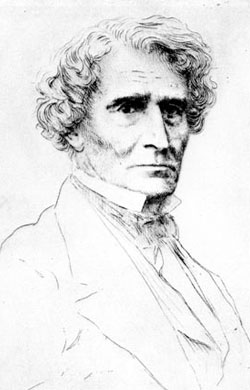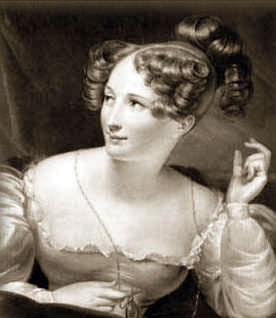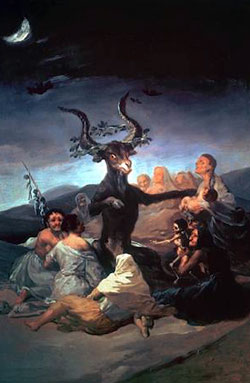|
|
|
 Berlioz in a portrait by Alphonse Legros
Before we go into length and dissect this wonderful piece, please allow me to give a small background of this wild and crazy guy. Hector Berlioz (born December 11th, 1803 in a small town in France and died 1869) was not born a prodigy, and he did not know much about playing an instrument either. He knew a little flute, clarinet, flageolet, and he could strum a few chords on the guitar, but by no means was he a virtuoso at any of these instruments.
Hector Berlioz’s father was a doctor and wanted Hector to become one as well. He sent him to study and become a doctor but, when he saw the sight of a dead corpse that a friend of his had bought to work on for a class he basically got sick and quit the whole medical concept. His father grudgingly gave Hector the money to study music, but he said he would stop paying for the music school that he was to study at and any lessons that he was supposed to take if he didn’t do well. His father didn’t like “second-rate” people.
 Henrietta Smithson in 1832
 The Witches’ Sabbath (1797-1798) by Francisco de Goya
It is fun to listen to how the Idee Fixe (fixed idea) changes upon the mood swings he feels about her. The first movement is entitled the “Reveries and Passions.” Here the Idee Fixe is introduced. It is hauntingly beautiful in nature and expresses the love that the “artist” (himself) feels for the subject (Harriet Smithson). The second movement is entitled “The Ball.” This piece has a three over four time signature (waltz) and describes a dance. But what is outstanding in this movement is that the Idee Fixe becomes this intertwined, in a back and fourth type of idea that gives the impression that he is thinking of her even when he is dancing at the ball – trying to forget her. If one were to think on a deeper level, one might think that this represents conscious and unconscious of ones self. The third movement is entitled, the “Scene in the Country.” He begins to have doubts about her love. The music becomes stormier and the psyche develops a feeling of “she loves me, she loves me not, she loves me, she loves me not.” This music happens to be pretty close to Sonata form. It has somewhat of a exposition, followed by a development section, which is followed by the recapitulation section. This movement ends with a sigh from the violins as if to say, she loves me not and all hope of her loving him is dashed away. The fourth movement is entitled, “The March of the Scaffold.” The character takes a strong dose of opium (a hallucinogenic), which made him have these strange dreams. He dreamt that he killed his beloved. He also dreamt that he witnessed his own death that was done by an execution. He was led to the scaffold by cart, through the streets. The people who witnessed this (during this movement) threw tomatoes and other rotten vegetables at him. During this movement one of the most famous descriptive moments in music happens, when he gets to the chopping block, he has one more thought of his beloved. This is interpreted again by the Idee Fixe, which is performed by a solo clarinet. Suddenly, (interrupted) the blade comes smashing down, WHAM! The head is chopped off and is demonstrated by three plunks by the violins, in an eerie descending fashion.The fifth movement is entitled, “The Dream of the Witch’s Sabbath.” He sees himself amidst ghosts and monsters that are laughing at him, poking fun at him and teasing him. Now, the theme (the Idee Fixe) becomes evil sounding. This represents that his beloved is now shown as an evil, wart-bearing witch. She does a cruel gig, played by the upper register of an Eb clarinet. This is shrill like, and adds to the texture and picture of this evil and degrading moment. Now, he does not desire her love nor does he want her by his side anymore.
Yes, folks it is like seeing his life before your very eyes. How dramatic! How crazy and insane! How wonderful!
Related resources:
| | - "Masterworks; A Musical Discovery, Holoman, D. Kern, Prentice Hall, Upper Saddle River, New Jersey, 1998" on Amazon.com
- "The Lives of the Great Composers; Third Edition, Schonberg, Harold C.,W.W. Norton Company, New York, 1997" on Amazon.com
- "Music: An Illustrated Encyclopedia Of Musical Instruments And The Great Composers, Wade - Matthews, Max, & Thompson, Wendy, Lorenz Books; Anness Publishing, London, 2004." on Amazon.com
|
The contents, views and opinions in this article are those of its author.
|
|
User comments:
|
 Wow... I learned a lot about Berlioz. Good work! Wow... I learned a lot about Berlioz. Good work! |
Posted by KevinJ on February 2nd, 2011 @ 12:03 pm GMT |
|
|
|
|
|
|
|